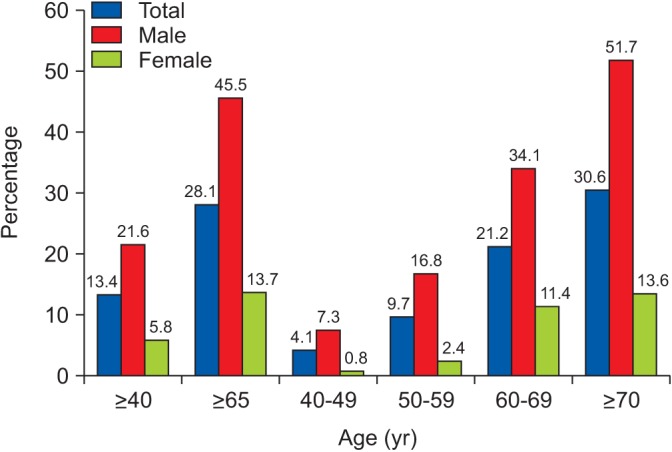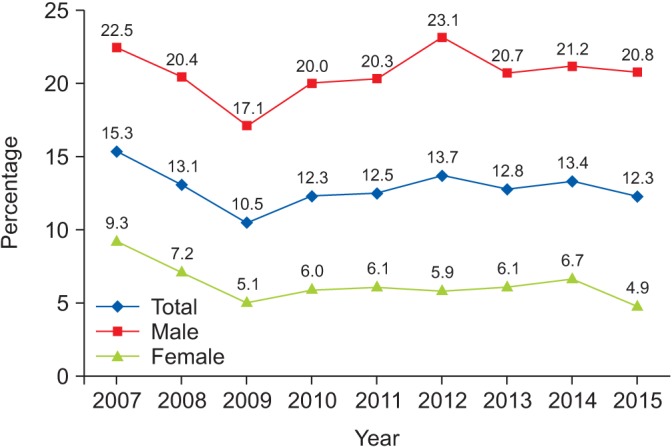 |
 |
| Tuberc Respir Dis > Volume 80(3); 2017 > Article |
|
Abstract
Chronic obstructive pulmonary disease (COPD) had been considered the only major disease that is continuing to increase in prevalence. There were a few studies about the change of the prevalence of COPD, which showed the prevalence of COPD did not increase. In this review, we report on the trends in the prevalence of COPD in Korea using the data from Korea National Health and Nutrition Examination Survey (KNHANES). The prevalence of COPD in 2015 was 13.4% (male, 21.6%; female, 5.8%). The prevalence of COPD did not change much, which ranged from 13.1% to 14.6% during the period from 2010 to 2015. Among the subjects found to have COPD by spirometry, only 2.8% had been diagnosed as COPD by physicians during the period from 2011 and 2015. In conclusion, the prevalence of COPD did not change significantly during the period from 2010 to 2015. And most COPD patients still had not been diagnosed by physicians and consequently had not been treated appropriately.
Chronic obstructive pulmonary disease (COPD) is characterized by persistent and progressive airflow limitation1. COPD has emerged as a serious public health concern in recent years, and is predicted to become the fourth leading cause of death worldwide by 20301,2.
The worldwide prevalence of COPD has been estimated to be 7.5%-10%3. In a nationwide COPD prevalence survey in Korea in conjunction with the second Korea National Health and Nutrition Examination Survey (KNHANES II) conducted 2001, 17.2% of Korean adults over the age of 45 years had COPD4. And, follow-up studies reported in 2011 showed the prevalence of COPD was 13.4% and 12.9%5,6.
There were a few studies about the change of the prevalence of COPD, which showed the prevalence of COPD did not increase7,8.
In this article, we briefly review the trends in the prevalence of COPD in Korea from 2007 to 2015 using the data from KNHANES9.
KNHANES is an ongoing surveillance system in the Republic of Korea that assesses the health and nutritional status of Koreans, monitors trends in health risk factors and the prevalence of major chronic diseases, and provides data for the development and evaluation of health policies and programs in Korea. KNHANES was initiated in 1998 by the union of ŌĆ£National Nutrition SurveyŌĆØ and the ŌĆ£National Health and Health Behavior Survey.ŌĆØ Since then, surveys for the KNHANES I, II, III, IV, V, and VI have been executed. The first three KNHANES were conducted as a triannual survey. To reduce the limitation of seasonal variations, beginning with the fourth KNHANES in 2007, it was converted to an annual survey to provide timely national statistics. The survey for the KNHANES VII is under progress since 2016. The KNHANES uses rolling sampling survey method for the sample in each year to present the whole nation and to be similar by years. Twenty households were selected throughout 192 regions each year and 10,000 individuals aged 1 year and over were targeted for KNHANES9.
In KNHANES, spirometry was performed by four technicians, each of whom underwent education sessions on pulmonary function test (PFT) and quality control5,6. Spirometry was performed using dry rolling seal spirometers (Model 2130; SensorMedics, Yorba Linda, CA, USA) and the American Thoracic Society/European Respiratory Society criteria for the standardization of PFT10. The prediction equation used in KNHANES was derived from the KNHANES II11. The results of spirometry in each enumeration districts were stored on web-hard to investigate whether the results satisfied acceptability and reproducibility criteria of spirometry for quality control and quality assurance. For analysis on results of spirometry, only results showing two or more acceptable curves and meeting reproducibility criteria were used6.
Also, trained interviewers administered the questionnaire at the time of spirometry, to determine whether (1) the subject had a history of COPD, such as chronic bronchitis or emphysema; (2) had been diagnosed with COPD by a physician; and (3) had been treated for COPD9.
The participants aged over 40 years recording less than 0.7 of forced expiratory volume in 1 second (FEV1)/forced vital capacity (FVC) were defined to have COPD5,6. To explore the trends of COPD prevalence from 2007 to 2015, KNHANES used age-standardized prevalence which was calculated using the age- and sex-specific structures of estimated population based on the 2005 Korea Census9.
In 2015, the prevalence of COPD was 13.4% (male, 21.6%; female, 5.8%) (Table 1). This figure was similar to those of previous studies5,6. The prevalence of the elderly aged over 65 years recorded 28.1% (male, 45.5%; female, 13.7%). And the prevalence became higher at older age by recording 4.1%, 9.7%, 21.2%, and 30.6% in the participants in their 40s, 50s, 60s, and 70s, respectively (Figure 1). In addition, the prevalence of COPD was higher in low income subjects than that of high income subjects (Table 1).
After conversion of annual survey during KNHNES IV, the prevalence of COPD seemed to be decreasing. However, the prevalence of COPD did not change much after 2010, which ranged from 13.1% to 14.6% during the period from 2010 to 2015 (Table 2).
KNHANES used the age- and sex-specific structures estimated population based on the 2005 Korea Census to explore the trends in prevalence of COPD. The age-standardized prevalence of COPD showed similar pattern (Table 2, Figure 2). This non-increase tendency of prevalence was comparable to other studies7,8.
It is well known that the public awareness of COPD is limited12,13,14 and a significant number of COPD patients have undiagnosed15,16. Among the subjects found to have COPD by spirometry, only 2.8% had been diagnosed as COPD by physicians during the period from 2011 and 2015. The treatment rate was 1.6% (Table 3). This figure did not improve compared to previous studies5,6.
KNHANES had some limitations. First, it did not exclude other diseases associated with airflow obstruction such as bronchiectasis and tuberculous destroyed lung because it did not utilize chest radiography. Second, the existence of airflow obstruction was evaluated with a fixed ratio using FEV1/FVC <0.7, so that the prevalence of the elderly could be overestimated. Moreover, as the golden standard of detecting COPD was based on postbronchodilator spirometry, KNHANES used only prebronchodilator test.
Acknowledgments
We appreciate all the efforts of the Korea National Health and Nutrition Examination Survey of Korea Centers for Disease Control and Prevention (KCDC).
References
1. Global Initiative for Chronic Obstructive Lung Disease. Global strategy for the diagnosis management, and prevention of chronic obstructive pulmonary disease. Updated 2016 [Internet]. Bethesda: Global Initiative for Chronic Obstructive Lung Disease; 2016. cited 2016 Apr 1. Available from: http://www.goldcopd.org.
2. Mathers CD, Loncar D. Projections of global mortality and burden of disease from 2002 to 2030. PLoS Med 2006;3:e442PMID: 17132052.



3. Halbert RJ, Natoli JL, Gano A, Badamgarav E, Buist AS, Mannino DM. Global burden of COPD: systematic review and meta-analysis. Eur Respir J 2006;28:523-532. PMID: 16611654.


4. Kim DS, Kim YS, Jung KS, Chang JH, Lim CM, Lee JH, et al. Prevalence of chronic obstructive pulmonary disease in Korea: a population-based spirometry survey. Am J Respir Crit Care Med 2005;172:842-847. PMID: 15976382.


5. Yoo KH, Kim YS, Sheen SS, Park JH, Hwang YI, Kim SH, et al. Prevalence of chronic obstructive pulmonary disease in Korea: the fourth Korean National Health and Nutrition Examination Survey, 2008. Respirology 2011;16:659-665. PMID: 21342331.


6. Hwang YI, Yoo KH, Sheen SS, Park JH, Kim SH, Yoon HI, et al. Prevalence of chronic obstructive pulmonary disease in Korea: the result of Forth Korean National Health and Nutrition Examination Survey. Tuberc Respir Dis 2011;71:328-334.

7. Vasankari TM, Impivaara O, Heliovaara M, Heistaro S, Liippo K, Puukka P, et al. No increase in the prevalence of COPD in two decades. Eur Respir J 2010;36:766-773. PMID: 20693258.


8. Soriano JB, Ancochea J, Miravitlles M, Garcia-Rio F, Duran-Tauleria E, Munoz L, et al. Recent trends in COPD prevalence in Spain: a repeated cross-sectional survey 1997-2007. Eur Respir J 2010;36:758-765. PMID: 19996189.


9. Korean Centers for Disease Control and Prevention. Korean National Health & Nutrition Examination Survey [Internet]. Cheongju: Korean Centers for Disease Control and Prevention; 2016. cited 2016 Jun 1. Available from: https://knhanes.cdc.go.kr/knhanes/main.do.
10. Miller MR, Hankinson J, Brusasco V, Burgos F, Casaburi R, Coates A, et al. Standardisation of spirometry. Eur Respir J 2005;26:319-338. PMID: 16055882.


11. Choi JK, Paek D, Lee JO. Normal predictive values of spirometry in Korean population. Tuberc Respir Dis 2005;58:230-242.

12. Hill K, Goldstein RS, Guyatt GH, Blouin M, Tan WC, Davis LL, et al. Prevalence and underdiagnosis of chronic obstructive pulmonary disease among patients at risk in primary care. CMAJ 2010;182:673-678. PMID: 20371646.



13. Hwang YI, Kwon OJ, Kim YW, Kim YS, Park YB, Lee MG, et al. Awareness and impact of COPD in Korea: an epidemiologic insight survey. Tuberc Respir Dis 2011;71:400-407.

14. Mun SY, Hwang YI, Kim JH, Park S, Jang SH, Seo JY, et al. Awareness of chronic obstructive pulmonary disease in current smokers: a nationwide survey. Korean J Intern Med 2015;30:191-197. PMID: 25750560.




15. Shin C, Lee S, Abbott RD, Kim JH, Lee SY, In KH, et al. Respiratory symptoms and undiagnosed airflow obstruction in middle-aged adults: the Korean Health and Genome Study. Chest 2004;126:1234-1240. PMID: 15486387.


16. Coultas DB, Mapel D, Gagnon R, Lydick E. The health impact of undiagnosed airflow obstruction in a national sample of United States adults. Am J Respir Crit Care Med 2001;164:372-377. PMID: 11500335.


Figure┬Ā1
Prevalence of chronic obstructive pulmonary disease in 2015, stratified by age and gender.




 PDF Links
PDF Links PubReader
PubReader Full text via DOI
Full text via DOI Print
Print Download Citation
Download Citation




